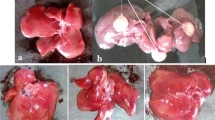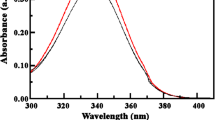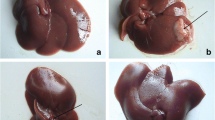Abstract
Hepatocellular carcinoma (HCC) is one of the commonest tumors worldwide. The treatment of HCC is vital for disease diagnosis and prognosis, as the liver is the most important organ controlling metabolic functions. Now-a-days, western folklore medicines are largely dependent on the phyto compounds which are highly effective in therapy and with low side effects. Luteolin is a flavonoid (3,4,5,7-Tetrahydro flavones) possess anti-inflammatory, anticancer and anti allergic property. The present study evaluates the efficacy of luteolin against N-nitrosodiethylamine (DEN) induced HCC in albino rats. In the highlight of the above, luteolin was evaluated for its efficacy against DEN induced HCC in male Wistar albino rats. The Biochemical parameters such as tissue damaging enzymes viz., AST, ALP, LDH and γ-GT, enzymatic antioxidants viz., SOD, CAT, GSH and GPx and histopathological changes have been estimated. The tissue damaging enzymes were found to be high in DEN alone treated group whereas the enzymatic antioxidants decreased destructively. Severe lesions and cirrhosis were observed in the toxin (DEN alone) treated group. The luteolin treated DEN group altered the tissue damaging enzymes and the enzymatic antioxidants. The damaged lesion in the histoarchitecture of DEN treated rat liver was almost completely restored. Finally this study strongly demonstrates that luteolin has potent curative property against HCC in albino rats.


Similar content being viewed by others
References
Parkin DM, Pisani P, Ferlay J. Estimates of the worldwide incidence of 25 major cancers. Int J Cancer. 1990;80:827–84.
Kapadia GJ, Azuine MA, Takayasu J, Konoshima T, Takasaki M, Nishino H, Tokuda H. Inhibition of epstein-barr virus early antigen activation promoted by 12-O-tetradecanoylphorbol-13-acetate by the non-steroidal anti-inflammatorydrugs. Cancer Lett. 2000;161:221–9.
Ramakrishnan G, Raghavendran HRB, Vinodhkumar R, Devaki T. Suppression of N-nitrosodiethylamine induced hepatocarcinogenesis by silymarin in rats. Chem Biol Interact. 2006;161:104–14.
Kim H, Cheon K, Kim BS, Kim HP. Effects of naturally occurring flavonoids on nitric oxide production in the macrophage cell line RAW264.7 and their structure-activity relationships. Biochem Pharmacol. 1999;58:759–65.
Kimata M, Inagaki N, Naga H. Effects of luteolin and other favonoids on IgE-mediated allergic reactions. Planta Med. 2000;66:25–9.
Bartsch H, Montesano R. Relevance of nitrosoamines to human cancer. Car-cinogenesis. 1984;5:1381–95.
Jeena KJ, Joy KL, Kuttan R. Effect of Emblica officinalis, Phyllanthus amarus and Picrorrhiza kurroa on N-nitrosodiethylamine induced hepatocarcinogenesis. Cancer Lett. 1999;136:11–6.
Loeppky RN. Nitrosamine and nitroso compound chemistry and biochemistry. In: ACS Symposium Series, vol. 553, Am Chem Soc. Washington:DC, 1994;1–12.
Lowry OH, Rosebrough NJ, Farr AL, Randall RJ. Protein measurement with the folin phenol reagent. J Biol Chem. 1951;193:265–75.
Reitman S, Frankel SA. Colorimetric method for determination of serum glutamic oxaloacetic and glutamic pyruvic transaminases. Am J Clin Pathol. 1957; 3856–3863.
King EJ, Armstrong AR. Estimation of alkaline phosphatase. Can Med Assoc J. 1934;311:152–6.
Szasz G. Reaction rate method for gamma glutamyl transferase activity in serum. Clin Chem. 1976;22:2031–55.
Kakkar P, Das B, Viswanath PN. Modified spectrophotometer assay of SOD. Ind J Biochem Biophys. 1984;95:51–8.
Aebi, Catalase, in: H.V. Bergmeyer (Ed.), Method in Enzymatic Analysis, vol.3, Academic Press, New York, 1997, 6373–6386.
Ellman GI. Tissue sulphhydryl groups. Arch Biochem Biophys. 1959;82:70–7.
Pagila DE, Valentine WE. Study on quantitative and qualitative characterization of erythrocyte glutathione peroxidase. J Lab Clin Med. 1967;702:158–63.
Habig WH, Pabst MJ, Jakoby WB. Glutathione-S-transferases: the first enzymatic step in mercapturic acid formation. J Biol Chem. 1974;249:7130–9.
Mori M. Electron microscopic and new microscopic studies of epatocyte cytoskeleton: physiological and pathological relevance. J Electron Microsc. 1994;43:347–55.
Lee LT, Huang YT, Hwang JJ, Lee AY, Ke FC, Huang CJ, Kandaswami C, Lee PP, Lee MT. Transinactivation of the epidermal growth factor receptor tyrosine kinase and focal adhesion kinase phosphorylation by dietary flavonoids: effect on invasive potential of human carcinoma cells. Biochem Pharmacol. 2004;67:2103–14.
Sonoda M, Nishiyama T, Matsukawa Y, Moriyasu M. Cytotoxic activities of flavonoids from two Scutellaria plants in Chinese medicine. J Ethnopharmacol. 2004;91:65–8.
Yamashita N, Kawanishi S. Distinct mechanisms of DNA damage in apoptosis induced by quercetin and luteolin. Free Radic Res. 2000;33:623–33.
Plaa GL, Hewitt WR. Detection and evaluation of chemically induced liver injury. In: Wallace Hayes A, editor. Principles and methods of toxicology. New York: Raven Press; 1989. p. 399–628.
Vásquez-Garzón VR, Arellanes-Robledo J, GarcaRomán R, AparicioRautista DI, Villa-Trevi S. Inhibition of reactive oxygen species and pre-neoplastic lesions by quercetin through an antioxidant defense mechanism. Free Radic Res. 2009;43:128–37.
Ketterer B, Meyer DJ. Glutathione-S-transferases: a possible role in the detoxification and repair of DNA and lipid hydroperoxides. Mutat Res. 1989;45:1–8.
Michiels C, Raes M, Toussaint O, Remacle J. Importance of Se-glutathioneperoxidase, catalase, and Cu/Zn-SOD for cell survival against oxidative stress. Free Rad Biol Med. 1994;17:235–48.
Bansal AK, Bansal M, Soni G, Bhatnagar D. Protective role of vitamin E pretreatment on N-nitrosodiethylamine induced oxidative stress in rat liver. Chem Biol Interact. 2005;156:101–11.
Rao GMM, Rao CV, Pushpangadan P, Annie S. Hepatoprotective effects of rubiadin, a major constituent of Rubia cordifolia Linn. J Ethnopharmacol. 2006;103:484–90.
Ara C, Kirimlioglu H, Karabulut AB, Coban S, Harputluoglu M, Kirimlioglu V, Yilmaz S. Protective effect of resveratrol against oxidative stress in cholestasis. J Surg Res. 2005;127:112–7.
Author information
Authors and Affiliations
Corresponding author
Rights and permissions
About this article
Cite this article
Balamurugan, K., Karthikeyan, J. Evaluation of Luteolin in the Prevention of N-nitrosodiethylamine-induced Hepatocellular Carcinoma Using Animal Model System. Ind J Clin Biochem 27, 157–163 (2012). https://doi.org/10.1007/s12291-011-0166-7
Received:
Accepted:
Published:
Issue Date:
DOI: https://doi.org/10.1007/s12291-011-0166-7




